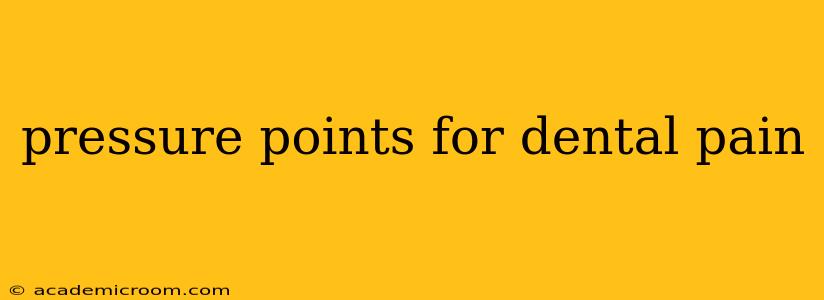Dental pain can be excruciating, often striking unexpectedly and disrupting daily life. While a dentist should always be consulted for diagnosis and treatment of persistent or severe dental pain, many find temporary relief through acupressure, stimulating specific pressure points to alleviate discomfort. This article explores several pressure points that may help manage dental pain, offering a complementary approach to traditional dental care. Remember, this information is for informational purposes only and does not replace professional dental advice.
What are Pressure Points?
Pressure points, also known as acupoints in Traditional Chinese Medicine (TCM), are specific locations on the body believed to correspond to energy pathways or meridians. Applying pressure to these points is thought to stimulate the flow of energy, potentially relieving pain and promoting healing. While the scientific evidence supporting acupressure for dental pain is limited, many individuals report finding it helpful for temporary pain management.
Key Pressure Points for Dental Pain Relief
Several pressure points are often associated with relieving dental pain. It's crucial to apply gentle, consistent pressure, avoiding any harsh or forceful manipulation.
1. LI4 (Hegu):
This point is located between the thumb and index finger, on the back of the hand. It's considered a powerful point for pain relief in general, and many find it effective for headaches and facial pain, including dental pain. Apply firm pressure for 1-3 minutes, several times a day as needed.
2. GB20 (Fengchi):
Located at the base of the skull, where the neck muscles meet, GB20 is often used to relieve headaches and upper body tension. Since dental pain can be associated with tension, stimulating this point might help ease overall discomfort. Gently massage this area in a circular motion for 1-2 minutes.
3. ST36 (Zusanli):
This point is located below the kneecap, on the outer side of the shinbone. It's a commonly used acupressure point known to have numerous benefits, including boosting immunity and easing digestive issues. While not directly related to the face, it can help with overall body balance and stress reduction, which may indirectly influence dental pain. Apply gentle pressure for 1-2 minutes.
4. SJ17 (Shuaigu):
Located on the jaw, near the temple, this pressure point is directly related to the face and head area. Gently pressing and massaging this point might help to reduce pain in the jaw and surrounding areas.
How to Effectively Use Pressure Points for Dental Pain
- Find a Comfortable Position: Relax and find a comfortable position where you can easily access the chosen pressure point.
- Apply Consistent Pressure: Use your thumb or index finger to apply firm, consistent pressure to the point. Avoid harsh pressing or rubbing.
- Breathe Deeply: Deep, slow breathing can enhance the effectiveness of acupressure by promoting relaxation.
- Hold for Several Minutes: Maintain pressure for at least one to three minutes. You can repeat this several times a day as needed.
- Listen to Your Body: Pay attention to how your body responds. If you experience any discomfort, reduce the pressure or stop immediately.
Does Acupressure Work for Everyone?
The effectiveness of acupressure varies from person to person. While some people find significant relief, others may not experience any noticeable effects. It's essential to remember that acupressure should be considered a complementary therapy and not a replacement for professional dental care.
When to See a Dentist
If you experience severe, persistent dental pain, swelling, or any other concerning symptoms, it's crucial to seek professional dental care immediately. Acupressure is a potential aid for temporary relief, but it cannot address underlying dental problems.
Other Considerations:
- Underlying Medical Conditions: Individuals with specific medical conditions may need to consult their doctor before using acupressure.
- Professional Guidance: For a more comprehensive approach, consider consulting a qualified acupressure practitioner.
By understanding and applying these pressure points correctly, you may find temporary relief from dental pain. However, remember that consistent dental hygiene and regular visits to your dentist are crucial for maintaining optimal oral health and preventing future problems. This information is not intended as a substitute for professional medical advice. Always consult with a qualified healthcare professional for any health concerns or before making any decisions related to your health or treatment.
